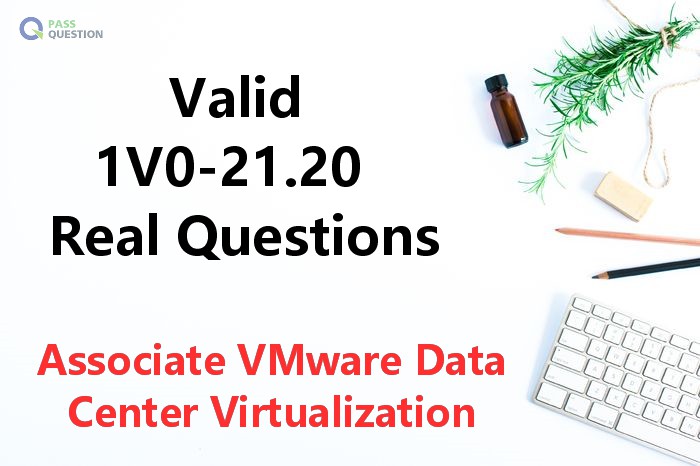Valid 1V0-21.20 Real Questions To Pass Associate VMware Data Center Virtualization
1V0-21.20 Associate VMware Data Center Virtualization exam is one of the most popular VMware Certification exams. PassQuestion has the right solutions for you to pass your VMware 1V0-21.20 Exam with confidence. PassQuestion offers economic 1V0-21.20 Real Questions with best quality and dynamic updates. Use PassQuestion for accurate 1V0-21.20 Real Questions for a successful preparation of 1V0-21.20 Certification Exam. We guarantees that after using our 1V0-21.20 Real Questions, you will be prepared to take and pass your VCTA-DCV Certification 1V0-21.20 exam in a easy way.

1V0-21.20 Exam Information - Associate VMware Data Center Virtualization
The Associate VMware Data Center Virtualization Exam (1V0-21.20), which leads to VMware Certified Technical Associate –Data Center Virtualization 2020 is a 51-item exam, with a passing score of 300 using a scaled method. Exam time is 135 minutes.The Associate VMware Data Center Virtualization exam tests a candidate's basic understanding of virtualization and vSphere concepts, data center technology and basic troubleshooting concepts.
Exam Number: 1V0-21.20
Exam Language: English
Associated Certification: VMware Certified Technical Associate – Data Center Virtualization 2020
Duration: 135 minutes
Number of Questions: 51 Questions
Passing Score: 300
Format: Single and Multiple Choice, Proctored
Sections Included in the Exam
Section 1 -Architectureand Technologies
Objective1.1: Identify how physical resources are presented to multiple virtual machines.
Objective 1.2: Identify how virtual resources can be shared across multiple virtual machines.
Objective 1.3: Identify examples of type 1 and type 2hypervisors.
Objective 1.4: Identify business challenges addressed by vSphere.
Objective 1.5: Identify the components of a vSphere environment.
Objective 1.6: Identify vSphere virtual networking components and types.
Objective 1.7: Identify the characteristics of storage access protocols for vSphere.
Objective 1.8: Identify the characteristics of vSphere storage technologies.
Objective 1.9: Identify the purposes of different virtual machine files.
Objective 1.10: Identify the types of OS that can run on virtual machines.
Objective 1.11: Identifyuse cases for virtual machine snapshots, cloning and templates.
Objective 1.12: Identify the functionality of the vSphere vMotion and Storage vMotion technology
Objective 1.13: Identify the use cases of vSphere vMotion and Storage vMotion technology
Objective 1.14: Identify the characteristics of vSphere High Availability and Fault Tolerance.
Objective 1.15: Identify use cases of High Availability and Disaster Recovery.
Objective 1.16: Identify the functionality of VMware Distributed Resource Scheduler (DRS).
Objective 1.17: Given a DRS score, identify the meaning.
Objective 1.18: Identify the use cases for Enhanced vMotion Compatibility (EVC).
Section 2 -VMware Products and Solutions–There are no testable objectives for this section
Section 3 -Planning and Designing–There are no testable objectives for this section
Section 4 -Installing, Configuring, and Setup
Objective 4.1: Identify Virtual Switch configuration options.
Objective 4.2: Identify how to configure different types of datastores.
Objective 4.3: Identify how to configure vSphere HA.
Objective 4.4: Identify how to configure vSphere DRS.
Objective 4.5: Identify how to configure EVC.
Section 5 -Performance-tuning, Optimization, Upgrades–There are no testable objectives for this section
Section 6 -Troubleshooting and Repairing–There are no testable objectives for this section
Section 7 -Administrative and Operational Tasks
Objective 7.1: Identify how to create and manage VM snapshots.
Objective 7.2: Identify how to manage VM templates and clones.
Objective 7.3: Identify the considerations when provisioning a VM.
Objective 7.4: Identify the options that can be performed on different inventory objects.
Objective 7.5: Identify the concepts of role-based user management
Objective 7.6: Identify virtual networking issues that impact vSphere.
Objective 7.7: Identify virtual storage issues that impact vSphere.
Objective 7.8: Identifythe purpose of monitoring alarms, tasks and events.
Objective 7.9: Identify how to monitor vSphere Cluster and SDRS Cluster.
Objective 7.10: Identify how to perform and monitor vMotion, Storage vMotion, and Cold migrations.
Objective 7.11: Given a vSphere environment, identify how to use performance charts to monitor the environment.
Objective 7.12: Identify the purpose for VMware Tools.
View Online Associate VMware Data Center Virtualization 1V0-21.20 Free Questions
What is the default encrypted vSphere vMotion state for virtual machines that are not
encrypted?
A. Enabled
B. Disabled
C. Opportunistic
D. Required
Answer: C
Which feature must be enabled to use vSphere Fault Tolerance?
A. vSphere HA
B. vSphere DRS
C. vSphere Replication
D. vSAN
Answer: A
Which hypetvisor is a type-1 hypervisor?
A.Oracle VM VirtualBox
B.VMware ESXi
C.VMware Fusion
D.VMware Workstation
Answer : B
A system administrator is preparing a host In a vSphere DRS cluster in partially automated mode for firmware patching and puts a host into maintenance mode. After several minutes, the host still has not entered maintenance mode.
How should the system administrator resolve this problem?
A.The system administrator needs to schedule DRS to run again.
B.vSphere Lifecycle Manager and DRS integration need to be configured.
C.vSphere HA admission control needs to be enabled on the cluster.
D.The system administrator needs to migrate virtual machines using vSphere vMotion.
Answer : D
Which IP storage is supported on vSphere?
A.SCSI
B.vSAN
C.SAN
D.ISCSI
Answer : D
Which vSphere feature protects against host hardware failures by restarting virtual machines (VMs) on hosts that are running in the cluster?
A.vSphere HA
B.vSphere vMotion
C.vSphere Fault Tolerance
D.vSphere DRS
Answer : A
- TOP 50 Exam Questions
-
Exam
All copyrights reserved 2025 PassQuestion NETWORK CO.,LIMITED. All Rights Reserved.

